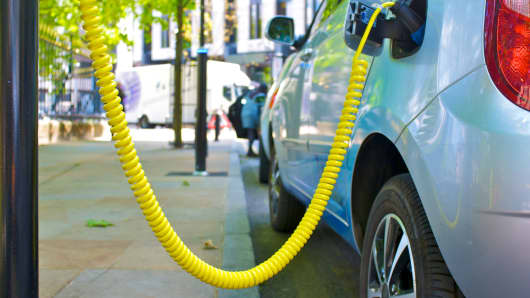A breakthrough in electrochemistry at Cambridge university could lead the way to rechargeable super-batteries that pack five times more energy into a given space than today's best batteries, greatly extending the range of electric vehicles and potentially transforming the economics of electricity storage.
Chemistry professor Clare Grey and her team have overcome technical challenges in the development of lithium-air batteries — the only cells theoretically capable of giving electric cars the range of petrol and diesel vehicles without having to carry excessively bulky and heavy battery packs.

Martin Pickard | Moment | Getty Images
If the technology can be turned from a laboratory demonstrator into a commercial product, it will enable a car to drive from London to Edinburgh on a single charge, with batteries that cost and weigh one-fifth of the lithium-ion cells that power today's electric cars.
"What we've achieved is a significant advance for this technology and suggests whole new areas for research," said Prof Grey. "We haven't solved all the problems inherent to this chemistry but our results do show routes forward."
Because lithium-air has such a big theoretical advantage over lithium-ion which dominates rechargeable batteries today — its energy density is potentially 10 times greater — researchers around the world are working on lithium-air.
A research paper published in the journal Science shows that the Cambridge group has overcome some of the practical problems of the technology, particularly the chemical instability that led to a rapid fall-off in performance of the lithium-air cells demonstrated previously.
The basic chemistry of lithium-air batteries is simple. The cell generates electricity by combining lithium with oxygen to form lithium peroxide and is then recharged by applying a current to reverse the reaction. Making these reactions take place reliably over many cycles is the challenge.
The Cambridge scientists adjusted the chemistry to make it more controllable. For example, they converted lithium peroxide to lithium hydroxide (a compound that is easier to work with), they added lithium iodide to the system and they made a very porous "fluffy" electrode from graphene, a form of carbon discovered 12 years ago at Manchester university.
The system demonstrated in the Cambridge lab is 90 per cent efficient, say the researchers, and it can be recharged 2,000 times. But they say at least another decade of work is likely to be required to turn it into a commercial battery for cars and for grid storage — storing the intermittent output of solar and wind generators for use when needed.
The Cambridge research has been funded by the UK Engineering and Physical Sciences Research Council, the US Department of Energy and the EU, with support from Johnson Matthey, the UK advanced materials company.
"We have patented the technology and the intellectual property is owned by Cambridge Enterprise, the university's commercialisation arm," said Prof Grey. "We are working with a number of companies to take it forward."

